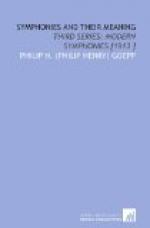Against all rules comes a new chorusing paean on the theme of Allegretto, led by stentorian basses, together with an enchanting after-strain, which we might have remarked before. And still another quarter, long hushed, is heard anew, as a voice sounds a faint reminder of the hymn of the first Allegro. Indeed, the combining strains before the close seem sprung all of one parental idea. The motto of the beginning sings in fittest answer to the latest phrases. The very maze of the concert forbids our turning to their first origin. The end is in joyous chanting of the Finale melody.
CHAPTER VIII
D’INDY AND THE FOLLOWERS OF FRANCK
Perhaps the noblest essay in symphonic music of the followers of Franck is the second symphony of Vincent D’Indy.[A] His vein is indeed throughout nearest akin of all the disciples to the serious muse of the master.
[Footnote A: Vincent d’Indy was born in Paris on March 27, 1852.]
Though D’Indy is surpassed in a certain poetic originality by some of his compatriot contemporaries, there is in this symphony a breadth of design and detail, a clear melodic quality and a sustained lofty feeling that seem to mark it the typical French symphony of its time. The strength of the work lies in a unity that is not merely of figure and outline. If we must measure a symphony mainly by the slow movement, we cannot avoid, with all the languorous beauty, a certain conventionality of mood, stressed with an exotic use of the appoggiatura, while in the Scherzo is a refined savagery of modern cacophony.
The directions are all in French; we are reminded of Schumann’s departure from the Italian fashion.
Each movement, save the third, has its prelude: a gathering of threads before the new story. The first notes of basses, together with the answer on high, sound a prophetic legend of the whole.
The harmonic lucubrations are profoundly subtle. Indeed the very nature of the first phrase is of dim
[Music: Extremement Lent. (Woodwind) (Strings and harps)]
groping; it ends in a climax of the answer and merges into the main song of the Allegro (tres vif) in horns, with rapid trip of strings.
[Music: Tres vif (Horns) (Strings)]
Throughout (from a technical view) is a fine mastery of the device of ornamental notes, and secondary harmonies; there is also a certain modern sense of chords and their relations. Together with an infinite brilliance of these resources there is not only no weakness in cogency of form, but there is a rare unity of design. The movements are bound together, at least in themal relation, as strictly as in any symphony. While the first phrase of the Allegro theme may hark back to the answer of original motto, the second is the main thread of narrative.
[Music: (Flutes, oboes and clarinets) Sempre staccato]




